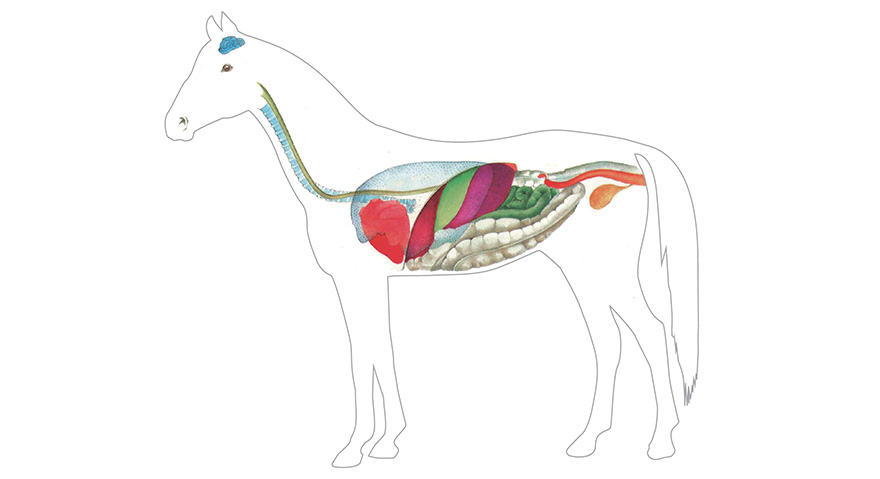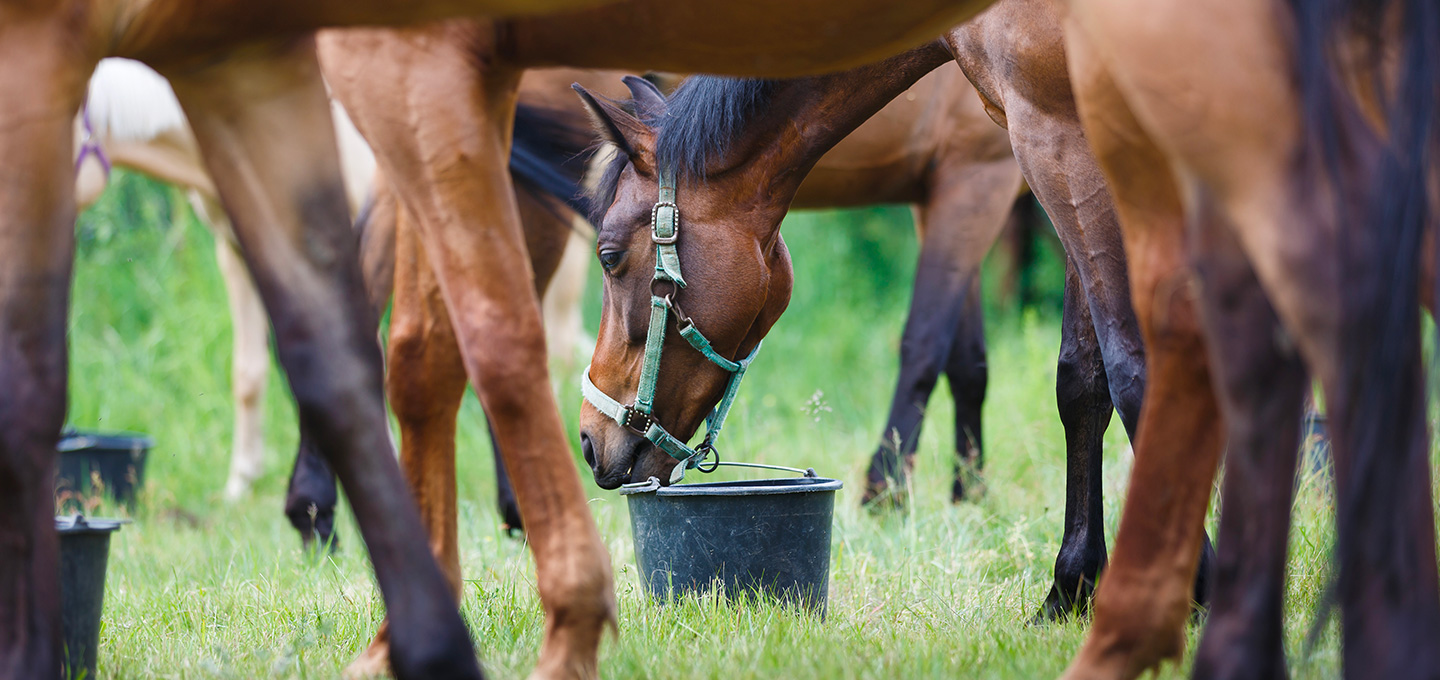Before addressing the horse nutrition, it is first necessary to focus on the functioning of its organism. The understanding of its digestive peculiarities, the growth of the foal or the muscular physiology of the horse at work is an essential prerequisite for the development of a balanced diet.

The mouth
TEETH
- Mastication: Fine grinding.
- 1 kg of hay = 40 minutes, 3000 actions of the jaw.
- 1 kg of cubes / pellets = 10 minutes, 1000 actions of the jaw.
SALIVA
- Humidifies feedstuffs: Facilitates the passage of feed through the oesophagus (lubrication) and buffers the stomachs’ acid secretions.
- 1 kg of hay = 4 litres of saliva.
- 1 kg of cubes / pellets = 2 litres of saliva.
Daily production = About 40 litres.
In practice
Have the wear and occlusion of the teeth checked at least once a year by a dentist.
Provide a sufficient quantity of forage (roughage), which will:
- Enable your horse to produce enough saliva to neutralise gastric acidity
- Occupy your horse, especially if he is stabled (the ingestion of 8 kg of hay > 5 hours)
The oesophagus
- Length: Approximately 130 cm.
- Transports feedstuffs to the stomach.
In practice
Provide your horse with clean water, correct hydration will facilitate the passage of the alimentary bolus through the oesophagus. Avoid cubes / pellets containing molasses, their agglomerating capacity increases incidents of oesophageal choke (obstructions).
The stomach
- Volume: 15 to 18 litres, but it is only ever filled to 2/3 of its capacity (10 to 12 litres). This small funtional capacity is suited for the ingestion of small meals.
- Length of transit: Half of the meal stays here for about two hours, the other half for 5 to 6 hours.
- Regulates the transit: Feed is passed to the small intestine in a sequential manner but a large starch rich feed will be held here longer than a small feed rich in fibres.
- A summary mechanical digestion.
- Gastric juices (pepsin, hydrochloric acid) are continuously secreted, at quantity of 10 to 30 litres a day: Start of the digestion of proteins.
- A bacterial flora producing abundant lactic acid: Ferments the most digestible carbohydrates into organic acids (lactic acid), aggressive for the gastric mucous.
In practice
- Distribute ad-lib hay.
- Divide the daily ration into multiple small feeds.
- Limit the quantity of highly digestible carbohydrates fed (= fermentable): Wheat, oats, flaked cereals, simple sugars (molasses), etc.
The small intestin = enzymatic digestion
- Length: Approximately 22 metres long.
- Volume: Approximately 70 litres.
- Duration of passage of foodstuffs: Approximately 4 hours.
- Powerful enzymatic secretions adapted to the alimentary content: Digestion of proteins, lipids and carbohydrates.
- Absorption of minerals (calcium, phosphorus, magnesium, trace elements etc.) and vitamins.
In practice
Optimise enzymatic digestion by dividing the daily ration into multiple small meals, this limits the risk of too much of undigested feed reaching the large intestine.
All changes of feed must be accompanied by a progressive transition over about a week.
This practice allows the organism to adapt its’ digestive secretions to the new feed, thus diminishing the risks of an appearance of digestive upsets related to the passage of undigested feed into the large intestine (colon).
The large intestine:
caecum + colon = microbial digestion
COLON
- Length: Approximately 6 to 8 metres.
- Volume: Approximately 96 litres.
CAECUM
- Length: Approximately 1.20 metres.
- Volume: Approximately 30 litres.
- Duration of passage of foodstuffs: Approximately 24 hours.
- A highly active microbial flora ferments the digestive contents on their arrival (mainly alimentary fibres but eventually also residual starch etc.).
- Production of volatile fatty acids which represent an important source of energy.
- Production of microbial unassailable proteins which are broken down into ammonia - a toxic product for the organism.
- Synthesis of Vitamin K and B group vitamins.
- Absorption of water (in the colon) allows the formation of droppings (faeces) which are expulsed by the rectum.
In practice
Provide plenty of fibres (i.e. ad-lib hay):
- To help ensure a healthy cellulytic gut flora.
- Provides bulk for the digestive system thus stimulating motility.
Support the intestinal flora by providing probiotics or prebiotics such as assimilation factors from the lactic fermentation of germinated barley, contained in most REVERDY feeds.
Favour quality over the quantity of protein in the ration in order to:
- Meet the requirements of essential amino-acids.
- Limit the amount of waste protein reaching the large intestine of which the final product will be ammonia (toxic).
To sump up
The horse is a monogastric herbivore presenting the following characteristics:
- The mouth: Very effective mastication.
- The stomach: Small in size, fast transit, and a gastric flora producing abundant lactic acid.
- The Small Intestine: Brief, but intense enzymatic digestion.
- The Large Intestine: Very developed, prolonged action of the cellulytic flora.
- Average duration of the digestive process = 30 hours.




